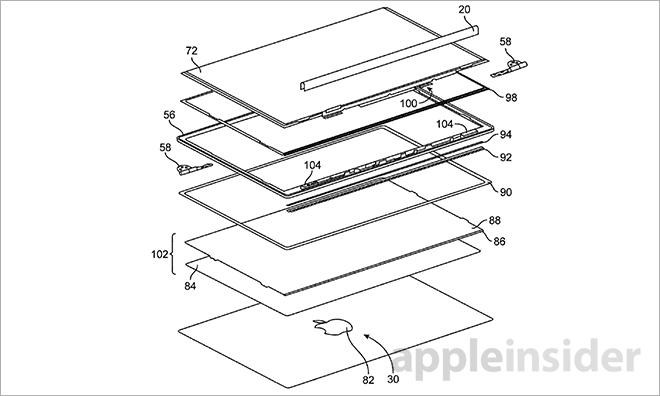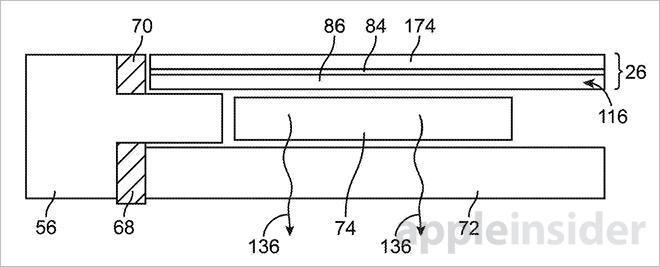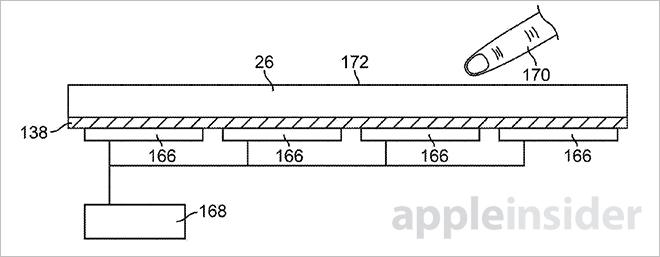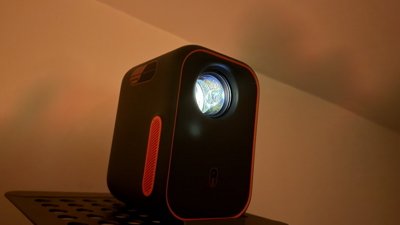The U.S. Patent and Trademark Office on Tuesday granted Apple a patent for a laptop with a unique display unit that not only serves as a solar power supply, but also an external screen and secondary means of touch input.
Apple's U.S. Patent No. 8,638,549 for an "Electronic device display module" describes a two-sided glass laptop display housing which carries the usual screen on its front face. On the rear, however, the module holds photovoltaic cells for solar charging, a secondary display and sensors for touch input.
As noted in the patent, the two-sided display may be manufactured using a variety of materials, including metal, ceramic, fiber composites and glass. In some embodiments, the rear of the display can be composed of electrochromic glass that allows light to pass through only when desired.
Much like the current MacBook lineup, a logo is disposed on the rear of the housing and can be illuminated via the same LED lighting as the front-facing display. Unlike current models, which feature an Apple logo made from translucent plastic embedded in the display chassis, the patent calls for the logo to be screened out of a patterned ink layer.
As noted above, in one embodiment the rear panel is made of electrochromic glass. Sometimes referred to as electrically switchable glass, the material can change state from translucent to transparent when a voltage is applied across its surface. This allows for a rear-facing display to remain hidden until user activation.
The electrochromic layer may also be disposed in a more granular fashion. In some cases, the layer that is divided into multiple sections like halves, quarters, eighths or other quadrants. Each section can be activated independently, allowing individual control and localized adjustments for light passage. For example, the layer may be activated to display a logo or reveal a small LCD display.
As for the touch sensors, the document implies any number of technologies can be deployed, including capacitive, optical and acoustic, among others. The sensors are able to collect touch data which is then translated into system commands. For example, a user can touch a certain area on the rear panel to unlock a magnetic latch mechanism that holds the display housing closed. In another example, pass codes, media controls and other software input may be managed from the rear sensor array.
Finally, Apple proposes a photovoltaic system may also be disposed between the rear panel and front-facing LCD screen. With the glass backing and electrochromic layer in transparent mode, light is able to hit photovoltaic cells, which in turn converts the energy into electrical power for storage or immediate use.
The patent goes on to describe in detail LED lighting techniques, construction and a variety of build options relating specifically to the display housing.
It is unknown if Apple will one day implement such an advanced component in its MacBook series of products, though the company has successfully manufactured dual-glass designs in smaller devices like the iPhone 4 and 4S.
Apple's two-sided laptop display patent was first filed for in 2010 and credits Adam T. Garelli, Dinesh C. Mathew, Thomas W. Wilson, Jr., Keith J. Hendren, Peteris K. Augenbergs, Brett W. Degner, Bradley J. Hamel, Michael A. Damlanakis and Patrick Kessler as its inventors.
 Mikey Campbell
Mikey Campbell










-m.jpg)






 Wesley Hilliard
Wesley Hilliard
 Malcolm Owen
Malcolm Owen
 Andrew Orr
Andrew Orr
 William Gallagher
William Gallagher
 Sponsored Content
Sponsored Content
 Christine McKee
Christine McKee

 Thomas Sibilly
Thomas Sibilly







18 Comments
i love typing on glass. i would like to see apple do away with the keyboard altogether and make that area a huge touchscreen. add haptic if people need it.
As noted in the patent, the two-sided display may be manufactured using a variety of materials, including metal, ceramic, fiber composites and glass...
…and sapphire.
Come on Apple, it's about time you pull a rabbit out of the hat and create the next "insanely great" device. Something that will astound people as much as the Mac did 30 years ago. Make it brilliant, make it do LOTS of great things that will change the way people currently think and work/play/live. Why? because I believe this is what Apple is all about and I think this will keep Apple going for another 30 years...
I like this idea. Apple could build a pretty secure laptop that embodies some touch screen facilities and won't even open up unless you enter a password on the touch screen.
Added to that the opportunity to just leave it lying on your desk and charging itself with all the free light that's floating about, and you're onto a winner.
All it has to do is look nice... and I'm pretty sure that Sir Jonny can do something fairly stunning with this... say, a unibonded clamshell with a silver look when the electrochromic glass is in the off-state. Alternatively, a return to the old 'insides on show' if it's left clear (I think that would look rather cool).
Either way, I really *WANT* one.
To sided displays have been so popular in the Windows world, let's bring them to the Mac. :no: